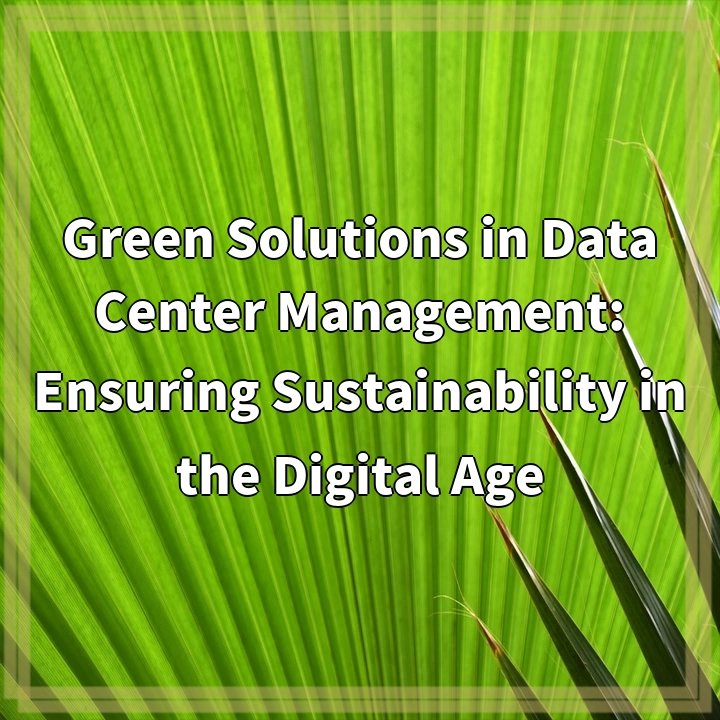
What it is:
Data centers play a crucial role in today’s digital age, serving as the backbone for storing, processing, and transmitting vast amounts of data. However, traditional data centers consume significant amounts of energy and contribute to greenhouse gas emissions, making them environmentally unsustainable. To address this issue, green solutions in data center management are being implemented to ensure sustainability in the digital age.
Real-World Problems:
Excessive Energy Consumption:
One of the major challenges in data center management is the excessive consumption of energy. Data centers require a substantial amount of electricity to power the servers, cooling systems, and other equipment. This not only strains the energy grid but also contributes to carbon emissions and global warming.
Heat Generation and Waste:
Data centers produce massive amounts of heat as a byproduct of their operations. Cooling systems are necessary to prevent overheating, but they consume additional energy and contribute to the overall inefficiency of traditional data centers. The waste heat generated is often released into the environment, resulting in environmental consequences.
E-Waste Management:
The rapid pace at which technology evolves leads to frequent upgrades and replacements of data center hardware, resulting in a significant amount of electronic waste (e-waste). Proper disposal and recycling of e-waste are critical to prevent harmful chemicals from polluting the environment and to make efficient use of valuable resources.
Water Usage:
Data centers also require significant amounts of water for cooling purposes. In regions with water scarcity or during droughts, water-intensive data center operations can strain local water supplies and exacerbate environmental challenges.
Carbon Footprint:
The combination of energy consumption, waste generation, and other environmental impacts contributes to the carbon footprint of data centers. This carbon footprint directly impacts climate change and the overall sustainability of our planet.
In the next sections of this blog series, we will explore various green solutions that address these real-world problems in data center management. These solutions include energy-efficient infrastructure, renewable energy integration, cooling methodologies, waste management strategies, and water conservation practices. By implementing these solutions, we can ensure a greener and more sustainable future for data centers in the digital age.

Solutions:
1. Energy-Efficient Infrastructure:
Data centers can implement energy-efficient technologies and practices to reduce their overall energy consumption. This includes utilizing energy-efficient servers, optimizing power distribution, implementing virtualization techniques, and using high-efficiency power management systems. By minimizing energy wastage, data centers can have a significant positive impact on sustainability.
2. Renewable Energy Integration:
Incorporating renewable energy sources, such as solar, wind, or hydroelectric power, can help data centers reduce their reliance on fossil fuels and decrease their carbon emissions. By installing on-site renewable energy generation systems or purchasing renewable energy credits, data centers can increase their use of clean energy and contribute to a more sustainable energy grid.
3. Cooling Methodologies:
Data centers can adopt innovative cooling methodologies to minimize the energy used for cooling purposes. This includes utilizing free cooling techniques, such as air-side economization or water-side economization, and implementing advanced cooling technologies like liquid cooling solutions. By optimizing cooling mechanisms, data centers can effectively manage heat generation and reduce their environmental impact.
4. Waste Management Strategies:
Efficient waste management is essential in data centers to minimize the environmental impact of e-waste. This involves implementing responsible disposal and recycling practices for outdated or decommissioned hardware. Additionally, data centers can explore opportunities for component reuse and minimize material waste through responsible procurement and product lifecycle management.
5. Water Conservation Practices:
Data centers can implement water conservation practices to reduce their water usage and minimize strain on local water resources. This can include adopting water-efficient cooling technologies, implementing water recycling and reuse systems, and selecting locations with access to abundant water sources. By conserving water, data centers contribute to sustainable water management and reduce their overall environmental footprint.
By adopting these green solutions, data centers can become more sustainable and environmentally friendly. These solutions not only reduce energy consumption and minimize waste but also contribute to the overall efforts of combating climate change and ensuring a greener future.















